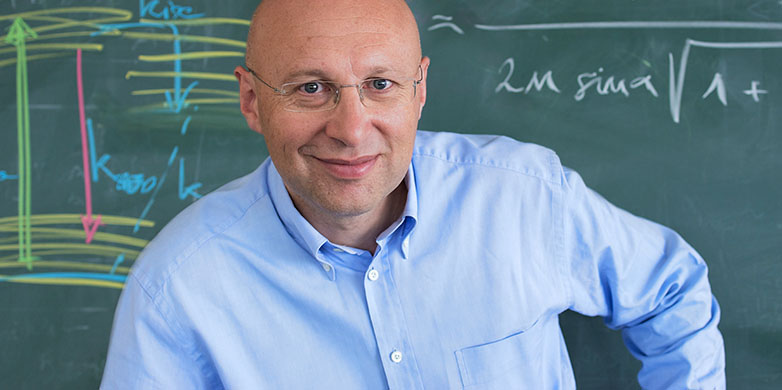Pauli Lectures take a look under the microscope
Using a trick with the optical resolution limit, Stefan W. Hell managed to break through the diffraction barrier in light microscopy, making it possible to obtain high-resolution images of the innermost workings of life. The chemistry Nobel laureate will now deliver this year’s Pauli Lectures at ETH Zurich.
For many years, natural scientists dreamed of making the tiniest of structures visible. Sharp images inside living cells, however, remained inaccessible to biologists for a long time. In 1873, Ernst Abbe determined that the diffraction of light presents a seemingly insurmountable limit to microscopic resolution: an optical microscope can only be used to discern structures that are larger than half the wavelength of the light used to illuminate the sample. The resolution limit was considered insurmountable for more than a century. One person who was undeterred by Abbe’s basic law was Stefan W. Hell. As a young researcher, the Romanian-German physicist set out to break the diffraction barrier in light microscopy and succeeded in doing so in the 1990s – using a clever trick.
A stroke of genius at the optical boundary
“Hell is an exceptional researcher and ingenious inventor,” says Matthias Gaberdiel, Professor of Theoretical Physics at ETH Zurich. “He was the first to find a way to circumvent Abbe’s diffraction limit in optical microscopes. His method enabled biologists and medical specialists to obtain high-resolution images of cell interiors and study life processes at the molecular level.” Gaberdiel is organising this year’s Pauli Lectures and was able to bring Hell on board as a lecturer.
Hell is considered the intellectual forefather and mastermind behind a special form of fluorescence light microscopy known as STED (Stimulated Emission Depletion), which offers a sharpness of detail that is no longer limited by light diffraction. To “cheat” this diffraction, Hell developed a method for controlling adjacent fluorescing molecules with two beams of light in a confined space, such that they can be made to fluoresce in succession. Both molecules would normally become blurred in an image from a classic microscope. Using Hell’s technique, it is possible to obtain images of objects at a resolution nearly ten times greater than previous methods allowed.
In this way, Hell revolutionised light microscopy: although penetrating into molecular dimensions was possible with an electron microscope, living cells or tissues could not be examined in this way because of the high-energy rays.
The life and work of a laureate
Hell is a researcher at the Max Planck Institute for Biophysical Chemistry in Goettingen and at the German Cancer Research Center in Heidelberg. He has received numerous accolades and awards for his achievements, most notably the Nobel Prize for Chemistry in 2014, awarded jointly with Eric Betzig and William E. Moerner. ETH Zurich’s Department of Physics has now honoured Hell by inviting him to deliver this year’s Wolfgang Pauli lectures.
During the ETH lecture series, which starts on Monday, 22 May, the 54-year-old Hell will talk about his journey to winning the Nobel Prize, provide exciting insights into the world of microscopy, and present the latest developments in his research field.
Pauli Lectures 2017
The Wolfgang Pauli Lectures, a three-part lecture series, have been held annually since 1962. The topics alternate between physics, mathematics and biology. The Pauli Lectures offer a forum for distinguished speakers to present their research. The lecture series is named after the theoretical physicist and Nobel laureate Wolfgang Pauli, who was a professor at ETH Zurich from 1928 until his death in 1958. The lectures, delivered in English, are open to the public and aimed at a wide audience with an interest in natural sciences. Entrance is free; prior registration is not necessary.
Lectures given by Stefan W. Hell:
- How I Got to Break the Diffraction Barrier of Optical Microscopy
Monday, 22 May 2017 (5.15 p.m.) Auditorium Maximum, HG F 30, ETH Zentrum, Rämistrasse 101, Zurich - Nanoscopy with Focused Light
Tuesday, 23 May 2017 (5.15 p.m.) Auditorium Maximum, HG F 30, ETH Zentrum, Rämistrasse 101, Zurich - Optical Nanoscopy: Concepts and Recent Advances
Wednesday, 24 May 2017 (3.30 p.m.) Lecture Room HCI G 3, ETH Hönggerberg, Vladimir-Prelog-Weg 1-5/10, Zurich
More information is available here

